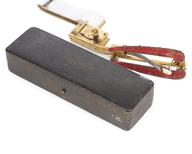





Vernon's percussor, English(?), 1801-1900
Percussion or tapping the chest to hear sounds was an early technique used to diagnose illness. Percussion was first used by Leopold Auenbrugger (1722-1809) in 1761. It was not widely practised until his Latin work on percussion was translated into French in 1808. Physician Henry Vernon standardised percussors in 1858. His design had a flexible whalebone handle with a metal head enclosed in a rubber ring.
Details
- Category:
- Clinical Diagnosis
- Collection:
- Sir Henry Wellcome's Museum Collection
- Object Number:
- A625162
- Measurements:
-
overall: 185 mm 25 mm, .02 kg
- type:
- percussor




